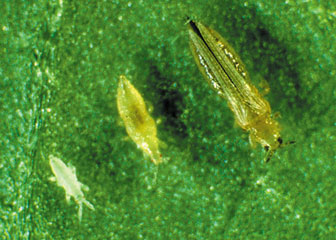Kansas cotton growers escape most of the damaging insects found deeper in the Cotton Belt. However, as cotton acres continue to rise in the state, producers and consultants must be aware of insect pests with the potential to cause significant yield loss in this crop.
Today, thrips are one of Kansas cotton growers' most consistent insect pests. This pest is of concern from late May until approximately the end of June, with most thrips problems in Kansas cotton related to thrips migrating from wheat as it matures in the spring. If this occurs as cotton plants emerge, seedlings can be stunted, and terminal buds or even entire plants may be killed. Thrips cause the most damage to cotton seedlings when dry conditions delay growth. When infestations occur, leaves may turn brown on the edges, develop a silvery color, or become distorted and curl upward (Figure 1). Light thrips infestations tend to delay plant growth and retard maturity. However, heavy infestations can kill terminal buds and cause abnormal branching patterns or even entire plants.

Figure 1. Cotton leaves damaged by thrips feeding. Photos courtesy of J.P. Michaud, K-State Research and Extension.
Scouting for thrips
Scouting for thrips can be difficult, but it is important to detect significant populations before economic damage occurs. Thrips are tiny (less than 2 millimeters long), barely visible, splinter-like insects that vary in color from yellow to brown to gray (Figure 2). They have rasping-sucking mouthparts, and adults have two pairs of narrow wings fringed with long hairs. Start looking for thrips as soon as plants begin to emerge, especially in the newest growth. In the field, shake cotton plants over a piece of white paper. If you see small, slender objects crawling, these are usually thrips. Be careful to differentiate these tiny insects from soil particles. Look for early signs of damage. Thrips feeding in the terminal tissue make new leaves appear distorted and curled. Under windy conditions, collect plants from the field and place them in plastic bags. Once out of the wind, examine plant terminals and the undersides of the first two leaves for the presence of thrips. Populations of more than one thrips per true leaf up to the six-leaf stage may justify treatment, depending on growing conditions. Control is rarely necessary later in the season.

Figure 2. Nymphal and adult thrips. Photo courtesy of J.P. Michaud, K-State Research and Extension.
Control options for thrips
Seed treatments to prevent thrips damage have been shown to provide good economic returns in cotton. If cotton is treated with a systemic insecticide at planting, it should be scouted for thrips two weeks after plants emerge. If live, immature thrips are found, it means that thrips are laying eggs in the field and residual properties of the seed treatment have elapsed. A follow-up foliar application may be necessary. Alternatives include applications of acephate and phorate as planting, or foliar treatments of dimethoate at a low rate from 0.12 to 0.25 lb. a.i./acre or acephate at 0.18 lb. a.i./acre. Chemical efficacy varies depending on the species of thrips being treated. Some populations express resistance to some materials. If one product does not seem to be working, try a different insecticide. A list of the insecticides labeled for thrips control in cotton is available in this KSRE publication: “Cotton Insect Pest Management 2024 at https://bookstore.ksre.ksu.edu/item/cotton-insect-pest-management-2024_MF2674. Always check insecticide labels carefully before applying a product to ensure safe and legal use.
Other early-season insect pest considerations
Cotton fleahoppers and lygus bugs should be monitored from the six-leaf stage until square production stops. Feeding damage from cotton fleahoppers and lygus bugs is very similar and both cause squares to drop. During the first three weeks of squaring, the economic threshold is 25 to 40 fleahoppers per 100 terminals with 10 to 15% blasted squares. With a sweep net, the threshold ranges between 4 and 6 fleahoppers per 25 sweeps. Treatment for lygus bugs may be needed with 1 to 2 lygus bugs per 25 sweeps. Alfalfa can be a significant reservoir for lygus bugs. So far this year, lygus bug populations in western Kansas alfalfa fields are notably high, so this is a pest to be more alert for going into the cotton growing season.
For more information on insect pest management in cotton, see the 2024 Cotton Insect Pest Management bulletin available from the KSRE Bookstore: https://bookstore.ksre.ksu.edu/item/cotton-insect-pest-management-2024_MF2674.
The use of trade names is for clarity to readers and does not imply endorsement of a particular product, nor does exclusion imply non-approval. Always consult the insecticide label for the most current use requirements.
Logan Simon, Southwest Area Agronomist – Garden City
lsimon@ksu.edu
Anthony Zukoff, Extension Entomologist – Garden City
azukoff@ksu.edu
Tags: insects cotton pest management thrips